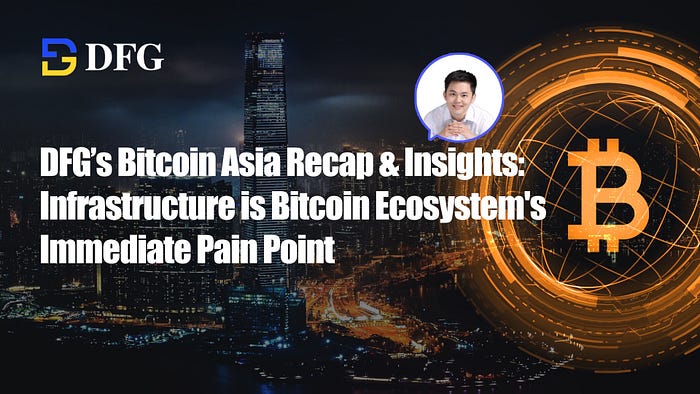DFG’s Bitcoin Asia Recap & Insights: Infrastructure is Bitcoin Ecosystem’s Immediate Pain Point

Author: James Wo, Founder & CEO, Digital Finance Group
On May 9, 2024, the first Bitcoin Asia conference was held in Hong Kong, which marks a significant shift from the previous Bitcoin conferences primarily held in Europe and America. This move has propelled the Asian Web3 industry to new heights. The discussion on the thriving Bitcoin ecosystem nowadays cannot go without mentioning the Asian market, including its developers and projects. Perhaps it was for this reason that Hong Kong was chosen as the starting point for this year’s Bitcoin conference. At the conference, the most talked-about topics were the macro aspects of the Bitcoin ecosystem and the current state and future development of Layer 2 technologies. Naturally, these discussions revolved around Bitcoin’s financial attributes and transactions. The conference brought together project teams, mining equipment manufacturers, wallets, ETF exhibitors, and exchanges, among other participants. From my observations over the two days, there were over 1,500 attendees. The guests were major contributors from various segments of the Bitcoin ecosystem.
Here are some key insights and personal reflections I gained from the conference:
Conference Focus
The core topic of this conference revolved around the Bitcoin ecosystem, especially those new tools and platforms aimed at optimizing trading strategies and improving transaction efficiency. Some developments were approached from a Layer 2 perspective, while others tackled issues from the perspective of the native chain, focusing on the core pain points of the Bitcoin network: scalability, security, and smart contracts.
Infrastructure Challenges
I noticed that many Bitcoin ecosystem entrepreneurial projects concentrated on building infrastructure. These projects are crucial in enhancing transaction speed, ensuring transaction security, and expanding network capacity. These are foundational supports for the long-term sustainable development of the Bitcoin network, despite facing financial and technical challenges. The numerous wallet exhibitors in the exhibition area also highlight a different phase compared to the Ethereum ecosystem. For the Bitcoin ecosystem to truly develop, more foundational infrastructures are needed.
Rise of Layer 2
Layer 2 projects were a prominent theme at the conference, showcasing how new layers built on top of the Bitcoin protocol can solve network scalability issues. This technological development is not only at the forefront of blockchain technology but may also lead the Bitcoin network toward a more efficient and scalable future. The two most discussed projects in their nascent stages were Merlin Chain and Dovi. Merlin Chain enhances its ecosystem’s functionality through its MERL token, offering governance features and highlighting compatibility with the Ethereum Virtual Machine (EVM), which enables seamless interaction with Ethereum-based decentralized applications (dApps), thus enhancing its attractiveness and practicality within the broader crypto ecosystem. Dovi, a community-driven Bitcoin Layer 2 solution, integrates the EVM to provide a scalable, efficient, and secure smart contract platform. Dovi supports various asset types, including BRC20 and ARC20 tokens, enabling fast and secure cross-chain asset transfers. While Layer 2 technologies hold great potential theoretically, I believe that at this stage, these technologies have not yet fully addressed some investors’ concerns, particularly those focused on security and stability. Perhaps those with conservative views need entrepreneurs to explore more direct solutions from the perspective of the native chain. As for developing applications on Layer 2, such as GameFi, I think it is still too early. These applications currently face many infrastructure issues, such as how to improve transaction speed and processing capacity, requiring more technological innovation and market validation.
In contrast, technology-focused projects that emphasize full-chain integration already have relatively mature solutions to address cross-chain, compatibility, and efficiency issues. For example, ZetaChain, which has recently gained significant attention and is now listed on the Coinbase exchange, can simplify interactions between different blockchain networks by providing cross-chain interoperability, thereby creating a more efficient and convenient blockchain ecosystem. ZetaChain allows the flow of assets and information between different blockchain networks, addressing the current problem of blockchain silos. Users can seamlessly transfer assets and data between different blockchains without relying on intermediaries. ZetaChain is already compatible with various major blockchains, including Ethereum, Bitcoin, and Polkadot, offering broad support to meet the needs of different users.
Interactions with Bitcoin Holders
In my interactions with several large Bitcoin holders, I found that they generally fall into two types of thinking: one is more conservative, preferring to hold Bitcoin long-term to enjoy its appreciation and increase passive income, making friends with time; the other is more willing to actively invest in Bitcoin infrastructure and new projects to promote the ecosystem’s active development. In a conversation with one of the major Bitcoin holders, the topic of the Babylon project came up. He mentioned that if Babylon could truly achieve its technical goals, he might change his conservative attitude to a more aggressive one, especially since DeFi Summer also made him a lot of money, and fixed income like Lido is also a favorite way for old money thinkers’ assets to appreciate. However, he may not know that there is already a project called ZKM (zkm.io) that has achieved the ability to share native assets without additional security assumptions. It combines Zero-Knowledge Proofs (ZKP) and MIPS architecture to achieve efficient computation while protecting privacy. Its Entangled Rollup can validate and relay the consensus of different blockchains without the need for additional consensus assumptions. Additionally, with their zkVM, integrated blockchains can interoperate with each other, allowing native liquidity to flow among different ecosystems.
Forked Event Pre Bitcoin Asia
At the Forked event held before Bitcoin Asia, DePIN and AI remained hot topics. Forked, a non-Bitcoin ecosystem event, had participants primarily from Europe and America, unlike other side events focused on the Bitcoin ecosystem. They are not as concerned about the Bitcoin ecosystem as Asians are but continue to explore the possibilities of DePIN and AI in the further development of Web3. These discussions demonstrated the intense attention and investment enthusiasm in these areas, especially considering the number of participants, which was much higher than other events focused on the Bitcoin ecosystem.
Conclusion
Thanks to our portfolio’s invitation, DFG also participated as a partner in our own portfolio’s event during Hong Kong’s event week, feeling the thriving Bitcoin ecosystem. The rise of the Bitcoin ecosystem and the launch of multiple Bitcoin ETFs in various regions are undoubtedly positive for the entire crypto industry. I look forward to seeing more bursts of new technology and the birth of good projects in the coming days.
About DFG
Digital Finance Group (DFG) is a global blockchain and cryptocurrency investment firm founded in 2015 with assets under management of over $1 billion through a wide range of sectors within the blockchain ecosystem such as Web 3.0, CeFi, DeFi, NFTs, and the Polkadot ecosystem.
Investments include Circle, Ledger, Coinlist, FV Bank, Astar, ChainSafe, and over 150 more. DFG intends to create value, through analytical research, based on the most impactful and promising global blockchain and Web 3.0 projects that will bring a paradigm shift to the world.
DFG Website: https://dfg.group
DFG Twitter: @DFG__Official
DFG LinkedIn: DFG
